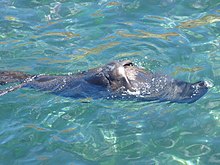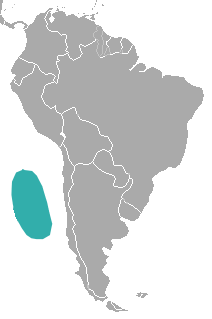Juan Fernández fur seal
| Juan Fernández fur seal | |
|---|---|

| |
| Conservation status | |
| Scientific classification | |
| Kingdom: | Animalia |
| Phylum: | Chordata |
| Class: | Mammalia |
| Order: | Carnivora |
| Suborder: | Pinnipedia |
| Family: | Otariidae |
| Subfamily: | Arctocephalinae |
| Genus: | 'Arctocephalus' |
| Species: | ''A. philippii'' |
| Binomial name | |
| Arctocephalus philippii Peters, 1866
| |

| |
| Juan Fernández fur seal range | |
The Juan Fernández fur seal (Arctocephalus philippii) breeds on the Juan Fernández Islands off the coast of Chile, named after the islands they were found on.[2] It is the second-smallest of the otariid seal (the closely related Galápagos fur seal is smaller still). Discovered by navigator Juan Fernández in the 16th century, the seals became a target for sealers in the Maritime Fur Trade era. They were thought extinct in the mid-20th century until a population of 200 was found. The population was protected and has grown quickly. There are now believed to be at least 10,000 animals on and around the island.
Description[edit]
The seals have a relatively robust body and a long, slender and pointed snout. They have stubby foreflippers and hindflippers, and a mane of long, coarse guard hairs from the top of the head to the shoulders. Adult males are dark brown to black, but the guard hairs can have yellow or tan tips. The males also have a more bulbous nose than the females and juveniles, as well as being longer than the adult females. The adult females have an overall brown colour, but the tips of the guard hairs may fade to yellow or tan. The females are less robust at the chest, neck and shoulders than the adult males. Pups are born black, but become lighter during the first few years. Males range from 150 to 200 cm long and weigh about 146 kg. Females are about 240 cm long and weigh about 50 kg.[2]
Reproduction[edit]
Breeding behavior is very territorial, especially the males who fight to maintain their territory. Females mate within their territory of the resident male. Mating season occurs during November and December which is only done once a year. The pregnancy lasts for a little less than a year. The females gives birth to only one pup, and nurses them from about 8 to 12 months.[2]
References[edit]
- ^ Template:IUCN2008
- ^ a b c Daniel Handysides: In: Script error: No such module "Vorlage:Internetquelle". ADW, abgerufen am 21. Oktober 2014.
External links[edit]
- Pages with script errors
- Wikipedia:Vorlagenfehler/Vorlage:Internetquelle
- Wikipedia:Vorlagenfehler/Vorlage:Cite web
- IUCN Red List near threatened species
- Articles with 'species' microformats
- Taxoboxes with the error color
- Taxoboxes with the incertae sedis color
- Taxobox articles possibly missing a taxonbar
- Arctocephalinae
- Endemic fauna of the Juan Fernández Islands
- Mammals of Chile
- Megafauna

